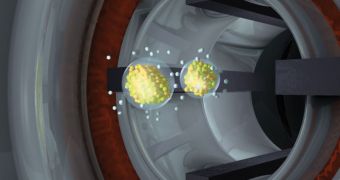The heavy elements occupy an area of the periodic table where other elements cannot be, and decay in fractions of seconds - an island in the sea, as nuclear physicists like to call it. This caused scientists to believe that other such islands, 'island of stability', may exist well beyond some of the superheavy elements in the periodic table of elements. Basically, what lies beyond the atomic number 114 is unknown, however researchers believe that stable superheavy elements should exist somewhere in that area.
"Now that is has been shown that the 'island of stability' of superheavy elements exists, it would be interesting to predict the position of other islands," said Yuri Oganessian, Ph.D. From Russia's Joint Institute for Nuclear Research and scientific leader at the Institute's Flerov Laboratory of Nuclear Reactions.
Oganessian has been working for the last six years with California's Lawrence Livermore Laboratory in order to synthesize five new superheavy elements bearing the atomic numbers 113, 114, 115, 116 and 117, thus proving that an 'island of stability' should exists in that area. Similarly to all elements heavier than hydrogen, superheavy elements are created through nuclear fusion inside stars.
On the other hand, throughout its life, a star can only fusion chemical elements lighter than iron (including iron). All elements heavier than iron are created during supernova explosions. Even so, supernova explosions are not powerful enough to create even the heaviest possible stable chemical elements. This is why superheavy elements do not occur naturally on Earth, but they are created inside high-energy particle accelerators by colliding lighter elements at high speeds.
In total, there are 118 chemical elements known to us, of which only 92 occur naturally on Earth, the rest being artificial elements created by man by accelerating lighter atomic nuclei at speeds of 10 percent the speed of light. As they collide, these atoms fuse with each other and create heavier elements, either stable or unstable.
The heaviest element ever created bears the atomic number 120 and was obtained by Oganessian and his team in the Dubna particle accelerator. Now he believes that even heavier chemical elements, which could even be stable for long periods, may exist. "The next island is located very far from the first one," said Oganessian. Some physicists predict that it could be somewhere around the atomic number 164, but at the rate of research today it would probably take a very long time before this element is even synthesized. What is needed is a more powerful particle accelerator, which could produce many more nuclides than they have been able to do so far, Oganessian believes.
"For this purpose, we need to increase the beam intensity, which will demand a new accelerator."
Superheavy elements may have extremely useful practical applications; however, what those applications may be is not the issue now, but creating these elements. Secondly, if they are discovered and proven to have useful practical application, mass production of these elements must be possible, which would be a process we have not mastered yet.
"I don't want to fantasize, but if they can devise a method for the production of superheavy element is large quantities, I am sure they can find some worthy application for these elements," said Oganessian.

 14 DAY TRIAL //
14 DAY TRIAL //